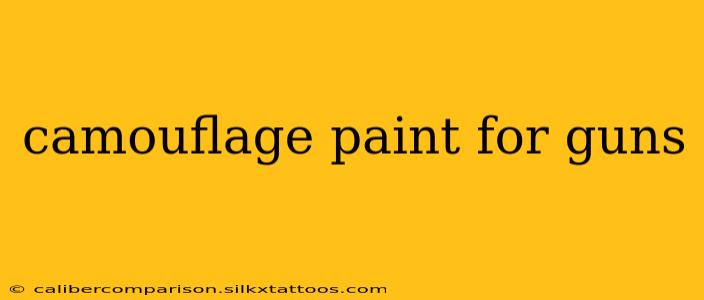Choosing the right camouflage paint for your firearm is crucial for effective concealment and a personalized touch. This guide delves into the various types of camouflage paint, application techniques, and considerations for maintaining your firearm's performance and longevity. Whether you're a seasoned hunter, a competitive shooter, or simply appreciate customizing your gear, understanding the nuances of gun camouflage will help you make an informed decision.
Types of Camouflage Paint for Guns
The market offers a wide array of camouflage paints specifically designed for firearms. Understanding their properties is key to selecting the best option for your needs:
1. Krylon Camouflage Paint: A Popular Choice
Krylon is a widely recognized brand known for its durability and ease of application. Their camouflage paints often come in various pre-mixed patterns, eliminating the need for custom blending. Krylon's formulations are typically designed to withstand the rigors of outdoor use, offering reasonable resistance to scratches and abrasion. However, it's important to note that Krylon, like many spray paints, can affect the firearm's functionality if not applied carefully.
2. Automotive Touch-Up Paint: A Budget-Friendly Alternative
Automotive touch-up paints can be a cost-effective alternative for smaller projects or repairs to existing camouflage jobs. While not specifically designed for firearms, many formulations offer good durability and a wide range of colors. However, they may not possess the same level of flexibility and resistance to solvents as paints specifically formulated for firearms. Careful selection and application are vital to prevent damaging the gun's finish.
3. Cerakote: The High-End Solution
Cerakote is a ceramic-based coating known for its exceptional durability, scratch resistance, and heat tolerance. It offers superior protection against the elements and wear and tear compared to traditional paints. Cerakote is often applied professionally, requiring specialized equipment and expertise. While more expensive than spray paints, the longevity and protection it provides make it a worthwhile investment for high-value firearms.
Applying Camouflage Paint to Your Gun: Techniques and Best Practices
Proper application is paramount to achieving a durable and aesthetically pleasing camouflage finish. Here are some key considerations:
1. Preparation is Key: Cleaning and Surface Preparation
Before applying any paint, thoroughly clean your firearm with a suitable gun cleaner and degreaser. This ensures proper adhesion and prevents paint from peeling or chipping. Remove any rust or loose paint, and lightly sand the surface to create a better bonding surface for the paint. Masking tape can protect areas you want to keep unpainted.
2. Applying the Paint: Thin Coats and Multiple Layers
Apply thin, even coats of paint, allowing each layer to dry completely before applying the next. Multiple thin coats are far superior to one thick coat, which is more prone to cracking and peeling. Follow the manufacturer's instructions regarding drying times.
3. Achieving a Realistic Camouflage Pattern: Techniques and Considerations
Achieving a realistic camouflage pattern requires patience and practice. Consider using stencils or masking tape to create sharp lines, or use freehand techniques for a more natural look. Experiment with different color combinations and blending techniques to create the desired effect.
4. Sealing the Finish: Protection and Durability
Once the camouflage paint is completely dry, applying a clear coat sealant can significantly enhance the durability and longevity of the finish. This extra layer of protection helps prevent scratches, chipping, and fading, extending the life of your camouflage job.
Maintaining Your Camouflage Finish
To keep your camouflage looking its best, avoid exposing your firearm to extreme temperatures or harsh chemicals. Regular cleaning with a soft cloth and mild cleaner will help maintain the finish and prevent dirt buildup.
Conclusion
Choosing and applying camouflage paint to your firearm is a rewarding process that allows for personalization and enhanced concealment. By understanding the various paint types, application techniques, and maintenance considerations, you can achieve a durable and aesthetically pleasing finish that enhances your shooting experience. Remember always to prioritize safety and adhere to all relevant firearms regulations.

